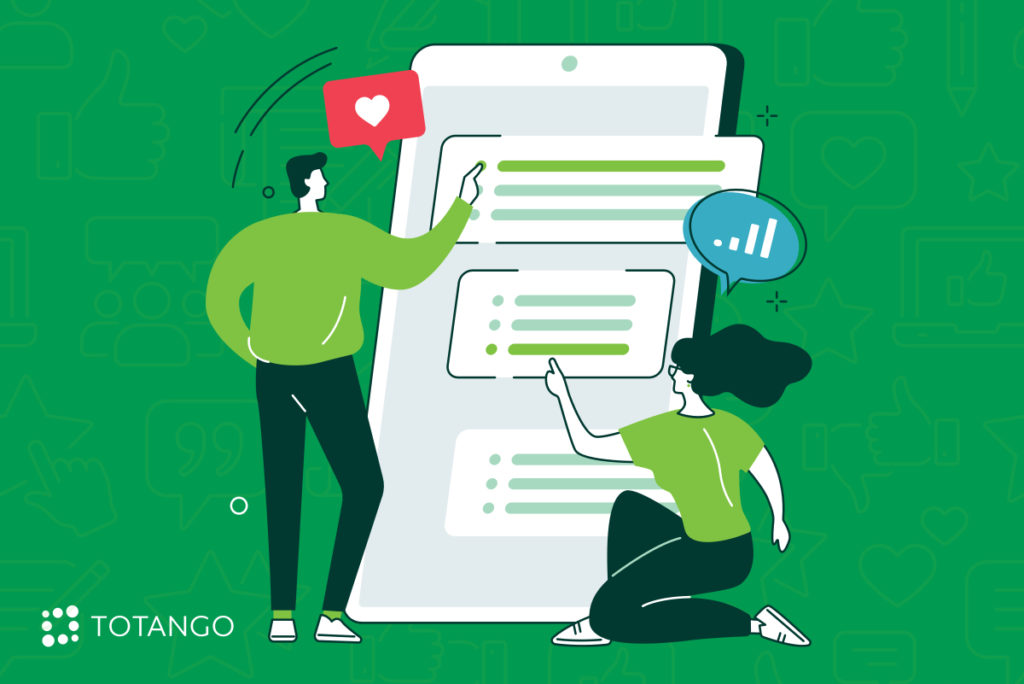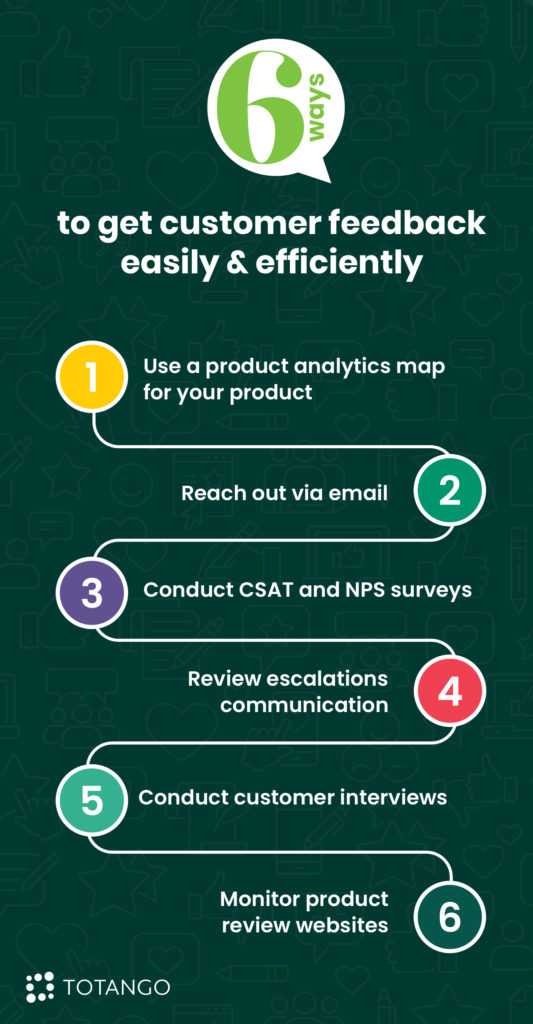Knowing how to get customer feedback can be tricky. First, there is the challenge of getting customers to share feedback. Customers who are upset will often spread their displeasure to others without ever telling you, while those who are satisfied may keep it to themselves. Even when you collect customer feedback, it may be gathered through different channels, stored in different data silos, and never coordinated and analyzed in an organized and actionable way.
Fortunately, today’s technology provides a number of ways to collect feedback easily and efficiently. Here’s how to get customer feedback effectively using six simple strategies which combine manual methods with the power of automation.
1. Use a Product Analytics Map for Your Product
In the SaaS industry, one of the best ways to get customer feedback is to see what customers are actually doing with your software product. Product analytics tools such as those built into Totango’s Spark customer success platform allow you to track how often users are interacting with your product and what they’re doing when they’re using it. You can monitor product adoption key performance indicators which tell you information such as how many accounts users have activated, how many times a day they’re logging into your portal, how long they’re spending in your app, and which features they’re using. This provides you with objective, measurable feedback on the value customers are gaining from your product.
You can then leverage this data by triggering automated workflows which promote higher engagement. Totango allows you to set up workflows called SuccessPlays which are triggered automatically or manually when pre-defined events occur.
2. Reach out via Email
One automated procedure you can implement to elicit customer feedback is triggering emails to request input at strategic points in your customer lifecycle. This can be done regularly on occasions that naturally suggest opportunities for requesting feedback, such as:
- Immediately post-purchase
- After onboarding has been completed
- After specific product adoption benchmarks have been achieved
- After a customer support issue has been resolved
- As a subscription renewal deadline approaches
- At customized intervals based on the customer’s individual data, such as the 30-day anniversary of their purchase
Create emails for these types of occasions, and set up your customer success software to automatically send emails at the appropriate times.
3. Conduct CSAT and NPS Surveys
You can integrate automated emails with surveys that measure customer satisfaction and enthusiasm for your brand. Two of the most important types of customer surveys are customer satisfaction (CSAT) and Net Promoter Score (NPS) surveys.
CSAT surveys measure customer satisfaction with product or service quality by asking customers to use a scale of 1 to 5 to respond to questions such as, “How would you rate your overall satisfaction with the customer support you received?” CSAT surveys are transactional and measure the experience of a specific transaction or interaction. NPS uses a scale of 0 to 10 to measure how likely a customer would be to recommend your brand to a friend or colleague. Totango tools such as the Voice of the Customer SuccessBLOC are set up to help you collect and track this kind of survey data as well as manage your customer interactions to increase satisfaction.
4. Review Escalations Communication
A more manual but extremely useful way of collecting feedback is by reviewing communications between customers and your staff during support escalation interactions. This affords you an opportunity to hear customers express their challenges, concerns, and complaints in their own words. This provides a different perspective than you would get from exclusively looking at data, and can give you insights you would not have gained otherwise.
You can combine this method with technology by assigning codes to customer escalation issues so you can digitize and compare data from different customers. This lets you track trends, analyze patterns and create automatically triggered solutions to common issues.
5. Conduct Customer Interviews
Another manual method of collecting feedback is conducting customer interviews. An advantage of interviews is that you can ask a flexible range of questions, giving customers more freedom to express their sentiments. You also have the advantage of being able to perceive body language as well as verbal communication.
You can design interview questions to focus on specific topics, such as user experience, onboarding issues, feedback about features or other areas of interest. To standardize and automate your interview procedures, consider designing sets of interview questions for different benchmarks in your customer lifecycle.
6. Monitor Product Review Websites
Reviews provide another important feedback resource. Software review sites such as G2 provide user reviews of products in different categories. Studying these reviews can help you see what your market is saying about your brand and product, where you’re doing well, and where you need to improve. For best results, create standard operating procedures for monitoring reviews and assign a member of your staff to supervise the implementation of your procedures.
Use Customer Feedback to Deliver Superior Customer Experiences
Knowing how to get customer feedback positions your brand to make improvements that deliver optimized customer experiences. Methods of collecting feedback include using automated tools such as product analytics maps, email, and satisfaction surveys as well as manual methods such as reviewing escalations communication, conducting interviews, and monitoring reviews. Although some methods incorporate manual review processes, even these methods can be integrated with technology by using automated monitoring tools, standardized processes, and centralized analysis of data from multiple channels.
Totango’s Spark customer success platform includes automated workflows and built-in KPI monitoring tools you can use to automate the process of eliciting, monitoring, analyzing, and applying customer feedback. Try it for free today to experience for yourself how Spark can help you streamline the process of collecting customer feedback and delivering satisfying customer experiences that build brand loyalty.


